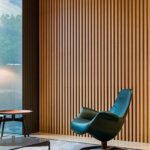Linear Wooden Wall Panel
Product Description
Technical Specifications
- Material: Solid Wood, MDFLAM, Natural Veneer, or Paint
- Thickness: 18 mm, 30 mm, 40 mm, 50 mm
- Panel Width: 80 mm, 100 mm, 120 mm, 140 mm, etc.
- Panel Gap: Can vary depending on the design.
- Panel Length: Can be produced to the desired dimensions based on project details.






